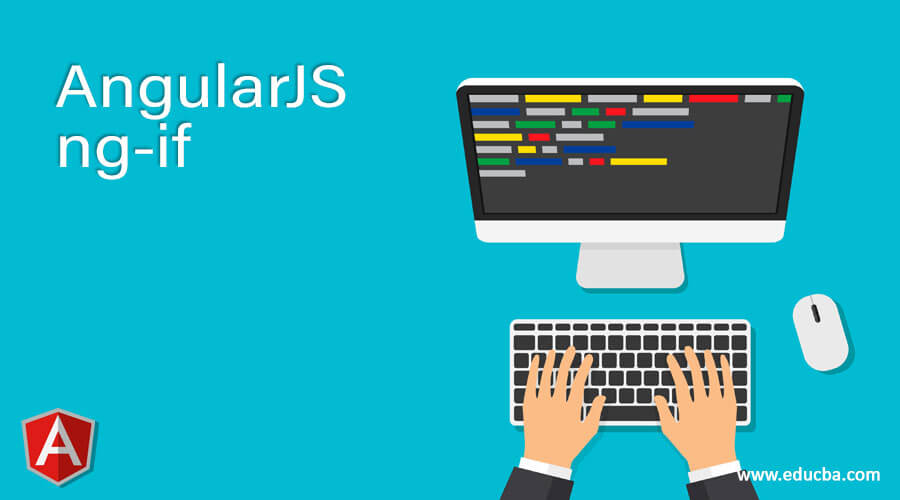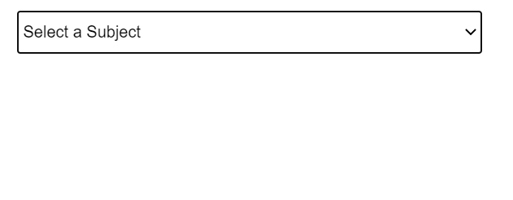Updated April 12, 2023

Definition of AngularJS ng-if
AngularJS ng-if is an In-Built AngularJS directive which can be used on HTML view Page to remove or add a particular section to the HTML view based on evaluation of expression defined in ng-if. As the name says, if the expression assigned to ng-if directive evaluates to TRUE Boolean value then that element gets added to the HTML view, else it is removed completely from the DOM itself.
Syntax
Using with INPUT Element
<input type="email" ng-if="isValidEmail()"
ng-model="emailValue" placeholder="Enter Email id"/>Using with SELECT Element
<select ng-model="selectedSubject" ng-if="showDropdown()"
ng-options="subject as subject.value for subject in subjects">
<option value="" selected>Select a Subject</option>
</select>Using with DIV Element
<div ng-if="showDivPortion()" ng-model="textAreaValue">This section will be displayed only if ng-if is evaluated to TRUE</div>Along with these ng-if directive can also be used with input type email, tel, checkbox, radio buttons, name, and all types of HTML tags.
How AngularJS ng-if works?
In AngularJS framework, it is very important to know that all the In-Built directive which have been provisioned by AngularJS framework will always be denoted with ng prefix. The expression defined in ng-if directive evaluates to a Boolean value i.e. True or False and based on this value the element is displayed on HTML DOM. Whenever the ng-if expression evaluation is a False value then that element is removed from the DOM itself. One very important difference between ng-if and ng-show directive is that, when expression evaluation of ng-if directive is FALSE, then the element is removed from the DOM itself whereas in case of ng-show, when expression return FALSE value then the element is hided in the DOM and not removed which is done using CSS property of display hidden.
Another point to keep a note is that when an HTML element is removed using ngIf its scope is completely destroyed and a new scope is created when the element is restored back in the view. The scope is inherits from ng-if’s parent scope. AngularJS ng-if directives is executed at priority level 600 and can be executed as multiElement.
Examples
Let us discuss examples of AngularJS ng-if.
Example #1
Index.html
<html ng-app="subjectapp">
<head>
<script src="https://ajax.googleapis.com/ajax/libs/angularjs/1.3.15/angular.min.js"></script>
<script src="script.js"></script>
<style>
.subject-dropdown {
width: 80%;
height: 35px;
line-height: 35px;
color: primary-blue;
border: 1px solid primary-blue;
margin-left: 40px;
}
.text-msg {
margin-top: 20px;
font-weight: bold;
text-align:center;
color: red;
}
</style>
</head>
<body>
<div ng-controller='SubjectController'>
<select class="subject-dropdown" ng-model="selectedSubject"
ng-if="onChangeOfSubjects()"
ng-options="subject as subject.value for subject in subjects">
<option value="" selected>Select a Subject</option>
</select>
<div class="text-msg" ng-if="selectedSubject">The subject selected is {{subjectValue}}
and subject Code is {{subjectCode}}
</div>
</div>
</body>
</html>Script.js
angular.module('subjectapp', [])
.controller('SubjectController', function($scope) {
$scope.subjects = [{'key': '01', 'value': 'English'},
{'key': '02', 'value': 'History'},
{'key': '03', 'value': 'Mathematics'},
{'key': '04', 'value': 'Science'},
{'key': '05', 'value': 'French'}];
$scope.onChangeOfSubjects = onChangeOfSubjects;
function onChangeOfSubjects() {
$scope.subjectValue = $scope.selectedSubject.value;
$scope.subjectCode = $scope.selectedSubject.key;
}
});In above example, we are trying to display a list of Subjects on UI using a select tag so that it will display in dropdown with various subjects available. To the select HTML tag, we have added ng-if directive, so as soon as the dropdown value is changed from its current ng-model value then ng-if will get triggered. This ng-if will execute function onChangeOfSubjects which is defined in the corresponding controller. Also as Subject is an object of key-value pair, we are displaying the name of the selected subject and its corresponding Subject code. Make sure to include the AngularJS dependency in Script tag so that you will be able to use the ng-repeat directive of AngularJS.
ng-if="onChangeOfSubjects()"Here onChangeOfSubjects method will get executed, whenever ng-if is triggered. It can accept any number of parameter and we are not passing any as we will be using scope model value in controller.
ng-model="selectedSubject"As discussed above, ng-if can work only with ng-model in this and so we have used ng-model in select
Just by using a few simple and easy CSS styling, we will be able to view the output of the above code.
Output:
Example #2
Index.html
<html ng-app="emailapp">
<head>
<script src="https://ajax.googleapis.com/ajax/libs/angularjs/1.3.15/angular.min.js"></script>
<script src="script.js"></script>
<style>
.email-input {
width: 80%;
height: 35px;
line-height: 35px;
color: primary-blue;
border: 1px solid primary-blue;
margin-left: 40px;
}
.text-msg {
margin-top: 20px;
font-weight: bold;
text-align:center;
color: Blue;
}
</style>
</head>
<body>
<div ng-controller='EmailController'>
<input class="email-input" type="email"
ng-if="onChangeOfEmail()"
ng-model="emailValue" placeholder="Enter Email id"/>
<p class="text-msg" ng-if="emailValue">Email id {{emailValue}} is {{validityValue}}</p>
</div>
</body>
</html>Script.js
angular.module('emailapp', [])
.controller('EmailController', function($scope) {
$scope.onChangeOfEmail = onChangeOfEmail;
function onChangeOfEmail() {
var re = /^(([^<>()[\]\\.,;:\s@\"]+(\.[^<>()[\]\\.,;:\s@\"]+)*)|(\".+\"))@((\[[0-9]{1,3}\.[0-9]{1,3}\.[0-9]{1,3}\.[0-9]{1,3}\])|(([a-zA-Z\-0-9]+\.)+[a-zA-Z]{2,}))$/;
$scope.validityValue = re.test($scope.emailValue) ? 'Valid' : 'Invalid';
}
});In above example, we are trying to accept input as Email id on UI using INPUT tag so that it will display the email id. To the input HTML tag, we have added ng-if directive, so as soon as the email id is entered or changed from its current ng-model value then ng-if will get triggered. This ng-if will execute function onChangeOfEmail which is defined in the corresponding controller. In this controller method, we will validate whether the email id is a valid email id based on pattern defined. If it’s valid we assign scope variable value as valid and if invalid, invalid string is assigned to validityValue. Make sure to include the AngularJS dependency in Script tag so that you will be able to use the ng-repeat directive of AngularJS.
ng-if=" onChangeOfEmail ()"Here onChangeOfEmail method will get executed, whenever ng-if is triggered. This method will be checking for whether it’s a valid email id or not.
ng-model=" emailValue "As discussed above, ng-if can work only with ng-model in this and so we have used ng-model in select
Just by using a few simple and easy CSS styling, we will be able to view the output of the above code.
Output:
Conclusion
ng-if directive in AngularJS is another most widely preferred and useful In-Built AngularJS directive which can be used for conditionally modifying the elements in HTML view. Knowing the syntax is all that is needed and you are ready to go.
Recommended Articles
We hope that this EDUCBA information on “AngularJS ng-if” was beneficial to you. You can view EDUCBA’s recommended articles for more information.




